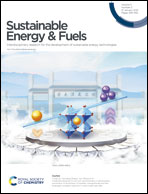A facile approach to fabricate Saccharum spontaneum-derived porous carbon-based supercapacitors for excellent energy storage performance in redox active electrolytes†
Abstract
In recent years, redox additive electrolytes have been anticipated as effectual selections over modest aqueous electrolytes. In the present study, porous carbon derived from nonporous Saccharum spontaneum confirms its efficacy as a supercapacitor electrode, in the presence of an optimized redox active electrolyte. Carbon synthesized via ZnCl2 activation at 600 °C shows optimum performance in terms of surface area (1590 m2 g−1) and porous properties. The same is reflected in the sample for excellent energy storage performance. High capacitances of 561 F g−1 and 275 F g−1 were obtained in an aqueous 1 M H2SO4 electrolyte, for three-electrode and two-electrode configurations, respectively. Similarly, with the incorporation of 0.01 M hydroquinone (HQ), as a redox additive to the 1 M H2SO4 electrolyte, a high specific capacity was achieved for three-electrode (1392 C g−1) and two-electrode (658 C g−1) configurations. Remarkably, a good cyclic stability of 77% retention after 5000 cycles has been evidenced in a HQ-incorporated aqueous electrolyte. A similar trend is followed for energy density, power density and other relevant electrochemical properties, as well.



 Please wait while we load your content...
Please wait while we load your content...